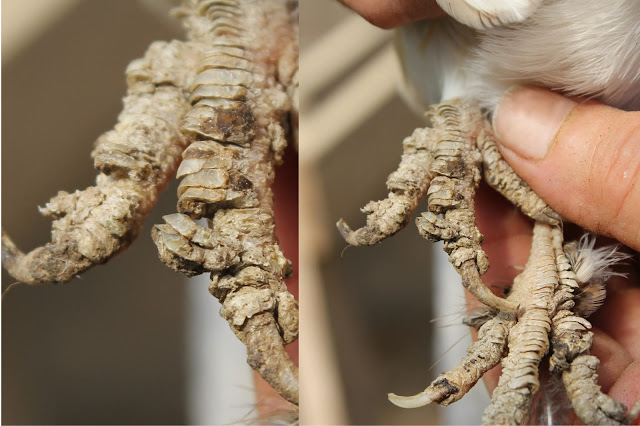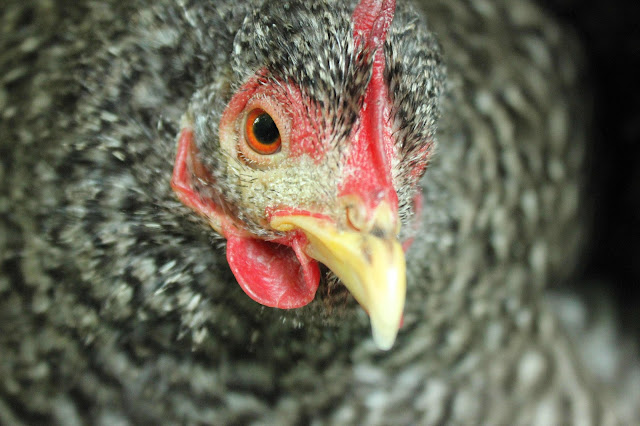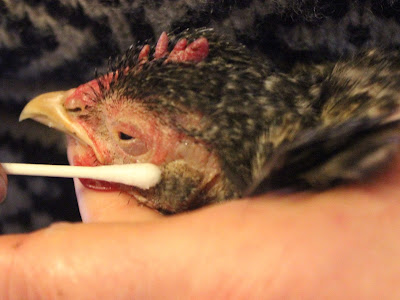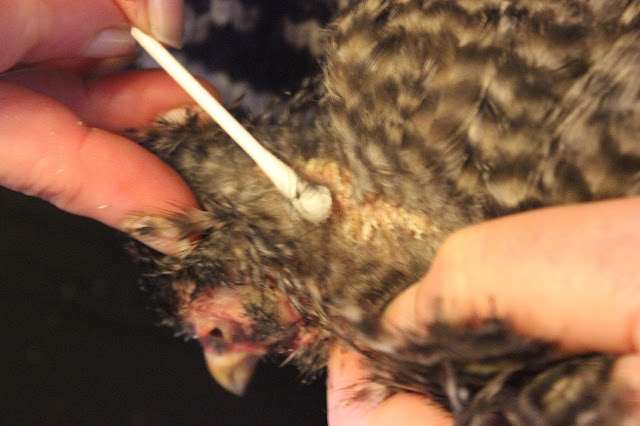Knemidocoptes mutans a very successful, microscopic burrowing mite, is one I have dealt with before within these pages in its relationship to my hens and cockerels. I also mentioned that it could be a major problem with game birds but at the time I had no photographic evidence to show - well I do now!
A couple of years ago Carol, a friend of mine in Honduras who runs a bird and animal sanctuary in her beautiful back garden, wrote asking me if I had ever come across scaly leg in quail and I wrote back to tell her that I hadn't but knew of it. She told me she had found it in several of the quail that she had recently rescued. I have also had commentators on my quail videos asking about my keeping quail and chickens together, in particular as I have hatched and raised quail many times with a bantam hen. The commentators usually have one particular theme: which is with specific reference to diseases that could be transmitted from one to the other. Well I have to say that I do not ally myself to Pasteur's 'germ theory' but to that of 'terrain' theory. If you are unaware of these two opposing theories then it might be a good idea to look into them as they are exceedingly relevant to all kinds of health issues. In fact it is a misnomer to even say that germ theory belonged to Pasteur as it had been around for some time before, for example, M. A. Plenciz, a Viennese physician, published a germ theory of infectious diseases in 1762. Conversely from Hippocrates 460-370 BC:
“It is more important to know what sort of person has a disease than to know what sort of disease a person has.”
The reason why I am mentioning the above in the same article now is because, having just bought six 'bargain basement ' quail from a friend who has moved and given up raising quail pro tem, I have finally come across scaly leg mite aka tassel foot in them. I believe this happened because these quail were kept with an old hen, whom I had noticed was suffering badly from the parasite. So although I don't believe in disease transmission from hen to quail, I do believe in that of parasites. Even so and if you know of my previous article and my discussion of the link between nutrition and parasitism, then I would add that the general state of the individual quail is what counts. Only one of these quail (pictured above top) has an infestation of Knemidocoptes mutans and she also had, before I cut them, extremely long nails, so I deduce has not been digging around for any extra wild nutrient.
Another of the females has slight scaly face or rather neck and the beginnings of scaly leg and she too did have exceedingly long nails. Thus I would suggest that this adds weight to the contention of there being a nutritional aspect to parasitism, which in turn dove-tails with terrain theory. Thus for any bird to get parasites from another host, it is the state of the bird the 'terrain' that is the important factor.
Another of the females has slight scaly face or rather neck and the beginnings of scaly leg and she too did have exceedingly long nails. Thus I would suggest that this adds weight to the contention of there being a nutritional aspect to parasitism, which in turn dove-tails with terrain theory. Thus for any bird to get parasites from another host, it is the state of the bird the 'terrain' that is the important factor.
 So just to recap what we are dealing with here, Knemidocoptes mutans, the burrowing mite that causes scaly leg and scaly face, is a short-lived arachnid, belonging
to the phylum Arthropoda, which also includes insects and crustaceans.
Like its relative the spider, it has eight legs although in contrast to
the former, it is viviparous, giving birth to live larvae. The female burrows down into the keratin of the skin and
underneath the scales of the bird to give birth, the nymphs also burrow
to create pockets in which to shed their skin. As I expressed in my previous article on the subject, I am not totally clear as to whether additional burrows are also due to them gnawing their way
through the keratin to consume it. In all I have read, I am not sure if,
like their cousins Knemidocoptes pilae, parasites of caged psittacines
and in particular budgerigars, the latter exude the enzyme keratinase in
order to help them break down and absorb the keratin. This enzyme in
itself seems to have irritant properties but once the holes are made,
there is a possibility that fluid and cells, combined with powdery
debris from the mite causes further problems. Certainly my less infested quail has been scratching her neck and as you can see from the above photo-montage abraded and removed some of her feathers. The major
problem with this mite is that although the conditions it causes are slow to develop to infestation proportion, if left to do so, they can become disfiguring, cause lameness or high facial and neck coverage and
lead to necrosis. However, there are specific steps, which can be taken to ensure that you
never have to deal with these consequences. As always prevention and a holistic approach is my priority.
So just to recap what we are dealing with here, Knemidocoptes mutans, the burrowing mite that causes scaly leg and scaly face, is a short-lived arachnid, belonging
to the phylum Arthropoda, which also includes insects and crustaceans.
Like its relative the spider, it has eight legs although in contrast to
the former, it is viviparous, giving birth to live larvae. The female burrows down into the keratin of the skin and
underneath the scales of the bird to give birth, the nymphs also burrow
to create pockets in which to shed their skin. As I expressed in my previous article on the subject, I am not totally clear as to whether additional burrows are also due to them gnawing their way
through the keratin to consume it. In all I have read, I am not sure if,
like their cousins Knemidocoptes pilae, parasites of caged psittacines
and in particular budgerigars, the latter exude the enzyme keratinase in
order to help them break down and absorb the keratin. This enzyme in
itself seems to have irritant properties but once the holes are made,
there is a possibility that fluid and cells, combined with powdery
debris from the mite causes further problems. Certainly my less infested quail has been scratching her neck and as you can see from the above photo-montage abraded and removed some of her feathers. The major
problem with this mite is that although the conditions it causes are slow to develop to infestation proportion, if left to do so, they can become disfiguring, cause lameness or high facial and neck coverage and
lead to necrosis. However, there are specific steps, which can be taken to ensure that you
never have to deal with these consequences. As always prevention and a holistic approach is my priority.Observations on possible nutritional deficiencies
My newly-bought quail were previously kept in a small, trodden-earth floored outbuilding with a 'deep litter' covering which could potentially provide invertebrates. The barn's single opening, a part-wired doorway which faced South allowed them direct access to sunlight. There was no evidence when I visited that they received very much vegetable matter in their diet. However they were on a game-bird feed which would have provided an albeit synthetic vitamin content, which their bodies would then have to convert to the natural form for assimilation.Low Vitamin A
Knemidocoptes mutans (portrait left) feeds on keratin, which is the
proteinaceous substance that protects the epithelial cells from stress
and damage. Epithelial tissue is the sheet of cells which covers the
body's surface or lines the body cavities. When we think of this in
relation to birds and mites we may consider the β-keratin found in
feathers, beaks, scales, claws and skin. Parasites are opportunists and
to multiply to infestation level they need a lot of food! As discussed in relation to my other birds, although in the main when we think of Vitamin A deficiency, we may at
first think of its effect on sight, this is but a part of the overall importance of this
fat soluble vitamin.
Vitamin A deficiency has a leading role in the maintenance of the
epithelium and it is here that the symptoms of deficiency are most
visible. Although the exact nature of the problem depends on the
locations and types of this tissue i.e. a primary build up of keratin or
squama (scale), the resulting condition is the same and can be simply expressed thus:
excess production of keratin = abundance of mite food
 |
| Grass is high in carotenoids, such as beta-carotene, a precursor to Vitamin A |
Incidentally à propos of Vitamin A, it is also crucial to quail as their ability to lay is said to be directly linked to the amount of Vitamin A stored in the previous year.
.....low Zinc
Zinc is critical to the transport transportation of Vitamin A from storage in the liver for use in the rest of the body. Ants contain the highest levels of zinc of any other creature and my quail love them! Above my quail devouring an ant nest I'd found in a flower pot, comprising ants and two kinds of eggs, their favourite being those of the flying ants which are much larger than the regular eggs and pink instead of white! My new quail were given an ant nest yesterday and completely and thoroughly consumed it!
...and low Vitamin D₃
The evidence of external mites will be a good indication that the
pathway of 7-dehydrocholesterol (the precursor to Vitamin D₃ has been compromised i.e. with the
blocking of the preen gland by excess keratin and thus the bird may
develop all kinds of conditions symptomatic of D₃ deficiency. One of
these conditions is, as you may have guessed, keratosis, the
over-production of keratin. With one door way to the sun, it is not always certain that all my purchased quail will have obtained their necessary daily dose of high energy ultraviolet b (UVB).
 |
| Our baby quail getting some rays |
Rather than repeat everything here and for more in depth information on vitamin and mineral deficiency and the role played by stress in the infestation by Knemidocoptes mutans, I have put links to my previous articles below.
In Part Two we'll look at the treatment and there will be an accompanying film.
Thanks for dropping by and do feel free to share experiences or ask for further information in the comment section. If you have enjoyed this piece and found it useful think about sharing it with your family and friends, on social media and also maybe about joining this blog and/or subscribing to my Youtube channel or even supporting us on Patreon or
Until next time, all the very best from sunny Normandie! Sue
RELATED ARTICLES
Scaly Leg & Scaly Face Quail 2 Treatment
In the following we will look at how to treat scaly leg and scaly face with organic, readily-available, effective and low cost solutions.....read moreScaly Leg and Face Mite Infestations Why They Happen & What To Do Part 1
I look at the correlation between specific
deficiency and parasitisation because it is fundamental to everything I
believe is wrong...read more
 Scaly Leg Mite Infestations What To Do Part 2
Scaly Leg Mite Infestations What To Do Part 2
I look at the options both medicinal and nutritional for dealing with this microscopic mite ...read more
Scaly Face Mite Infestations Treatment Part 3
If you haven't this miraculous substance already in your pantry then I
advise you to get some, both for your own and your poultry's health...read more
© 2020 Sue Cross
Quail Why and how? Getting started.
I had read that for centuries in Japan and China quail eggs had been
used in the treatment of various respiratory diseases and allergies.
Finding no organic eggs on the market, I decided to raise them myself...read more
Quail Hatch - Taking you through the first few days.
Polly and the quail at three days old and already something of a
handful! I kept them in the nest for the first three days, letting them
gain in strength...read more
 How your hen can bring out the best in baby quail.
How your hen can bring out the best in baby quail.
Years of selective breeding have not only bred the broodiness out of
domesticated quail but also their ability to identify and seek out their
own food. read more
© 2020 Sue Cross
Illustrations of scaly leg mites with thanks to the Pinterest boards of:
zooclub.ru
University of Edinburgh - StudyBlue
diendancacanh.com



























